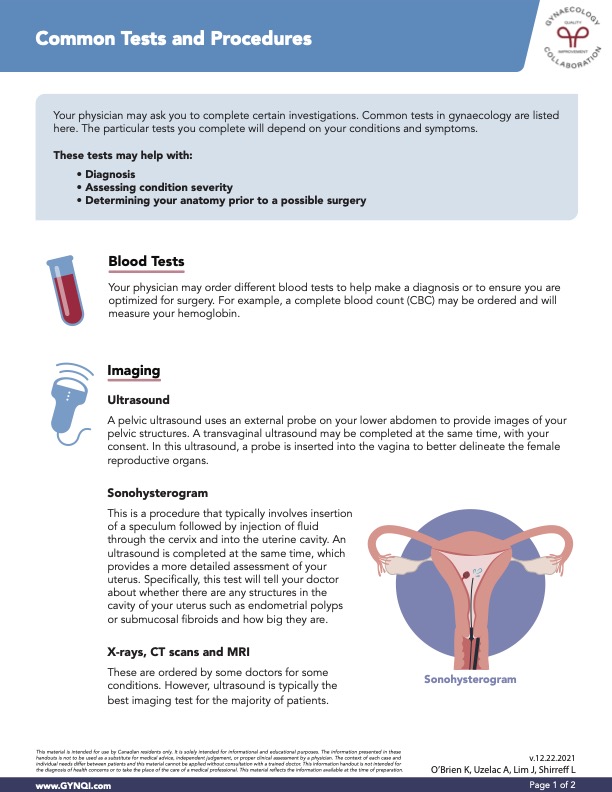

Table of Contents
- Summary
- Common Tests in Gynaecology
- Blood Tests
- Imaging
- Procedures
- Pap Test
- Endometrial Biopsy
- Dilation and Curettage (D&C)
- Hysteroscopy
- An Overview of Procedures to Treat Gynaecological Concerns
Summary:
- Physicians may recommend specific tests to diagnose gynaecological conditions, assess severity, and determine anatomical details before potential surgery, based on individual symptoms.
- Various blood tests, including a complete blood count (CBC), can help with diagnosis and ensure readiness for surgical procedures.
- Imaging tests, such as ultrasounds and sonohysterograms, provide detailed views of pelvic organs, aiding in diagnosis and treatment planning.
- Essential procedures like Pap tests, endometrial biopsies, D&C, and hysteroscopy allow for effective diagnosis and treatment of gynecological issues, ensuring optimal reproductive health.
When experiencing gynecological conditions or symptoms, your physician may recommend various tests to ensure a thorough assessment of your health. The specific tests you undergo will depend on your individual symptoms and concerns, and they play a crucial role in diagnosing conditions, evaluating their severity, and determining your anatomy prior to potential surgery.
Through blood tests, imaging, and other essential procedures, your doctor can gain valuable insights into your gynaecological health, ultimately guiding effective treatment options tailored to your needs.
Common Tests in Gynaecology
If you are experiencing any gynaecological conditions or symptoms, your physician may ask you to complete certain investigations. The particular tests you complete will depend on your symptoms.
These tests may help with:
- Diagnosis
- Assessing condition severity
- Determining your anatomy prior to a possible surgery
Blood Tests
Your physician may order various blood tests to aid in diagnosis or to ensure you’re prepared for surgery. For example, a complete blood count (CBC) can be used to measure your hemoglobin levels.
Imaging
Imaging tests provide detailed views of your pelvic organs, helping your doctor diagnose conditions and guide treatment decisions.
Ultrasound: A pelvic ultrasound involves using an external probe on your lower abdomen to capture images of your pelvic structures. With your consent, a transvaginal ultrasound may also be performed. This involves inserting a probe into the vagina for a clearer view of the reproductive organs.
Sonohysterogram: This procedure usually involves inserting a speculum, followed by injecting fluid through the cervix into the uterine cavity. An ultrasound is performed simultaneously, allowing for a detailed assessment of your uterus.
This test helps identify any structures within the uterine cavity, such as endometrial polyps or submucosal fibroids, and provides information about their size.
X-Rays, CT Scans, and MRI: These may be ordered for certain conditions, but ultrasound remains the preferred imaging test for most patients.
Procedures
Essential procedures in gynaecology allow healthcare providers to diagnose and treat various conditions effectively, ensuring optimal reproductive health.
Pap Test
A Pap test is a simple office procedure involving a speculum exam. During the exam, your doctor uses a small brush to collect cells from the cervix, which are then tested for any precancerous or cancerous changes.
Endometrial Biopsy
This is a brief office procedure where a speculum is inserted into the vagina, and a small pipelle is gently passed through the cervix into the uterus to collect a sample of the uterine lining.
Some may find this procedure uncomfortable and difficult to tolerate in an office setting. If that’s the case, your doctor might recommend a short procedure in the operating room under anesthesia instead.
Dilation and Curettage (D&C)
This procedure provides a more detailed assessment of the uterine cavity compared to an endometrial biopsy. Performed in the operating room under anesthesia, it involves using a tool called a ‘curette’ to gently scrape tissue from all sides of the uterine cavity.
It can be done as a standalone procedure or following a hysteroscopy.
Hysteroscopy
Typically performed in the operating room, the procedure involves inserting a small camera through the vagina and cervix into the uterus. Fluid is used to gently expand the uterine cavity, allowing your doctor to directly view its interior.
During the hysteroscopy, a tissue sample may be taken under direct visualization if needed.
An Overview of Procedures to Treat Gynaecological Concerns
Common tests and procedures in gynaecology play a crucial role in diagnosing and managing various conditions. These procedures ensure that you receive tailored care based on your specific symptoms and needs. Blood tests, imaging, and various in-office or operating room procedures enable your doctor to thoroughly assess your gynecological health, facilitating accurate diagnoses and effective treatment options to enhance your overall well-being.



